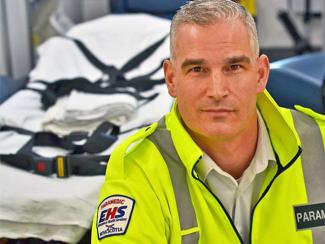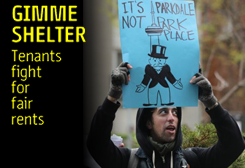CODE CRITICAL
NS paramedic twitter campaign seeks workplace and public safety

NS Paramedic Scott Sturgeon
THEY CALL IT "CODE CRITICAL". But the government continues to ignore warnings from the 1,100 paramedics in Nova Scotia. This is bad for the paramedics and bad for the general public, says the union representing them. So bad the paramedics have taken to twitter to warn the public about it.
IUOE (International Union of Operating Engineers) Local 727 launched their hashtag #CodeCritical twitter campaign in February 2018 to alert the public to major problems with the Nova Scotia ambulance service and its negative impacts.
For the 1,100 paramedics in Nova Scotia the problems bring increased stress due to long delays in offloading patients at backed-up hospital emergency rooms, paramedics being randomly shuffled from one region to another to cover service gaps and too few paramedics overall to meet the ever-increasing demand for ambulance care.
For the general public the problems also bring increased stress, and even danger, due to the uncertainty of how long it will take to get an ambulance.
“It’s our people, our paramedics who are stressed and going long days with very little to eat, then being mandated into overtime,” he explains. “It’s a workplace issue as well as public safety issue.”
Any delay is too long
In urban areas, ambulances are supposed to arrive within 8 minutes and 59 seconds. However, there are reports of ambulances taking over an hour to reach their destination.
Each and every delay carries great risk, says Terry Chapman, CEO of IUOE Local 727. “There was one event where there were three critically injured patients—near-death incidents—and those people waited 28 minutes, 37 minutes and one 48 minutes for an ambulance. The ambulance station was literally seven minutes away.” He added that fatalities resulted.
“I can’t specifically say the lack of ambulance caused a death. But who knows if anyone would have died, if an ambulance had been there in nine minutes instead of 48,” he said.
Scott Sturgeon, a frontline paramedic, says it was common in 2018 for paramedics to wait with patients on stretchers for up to 12 hours at the Halifax Infirmary. “When I first started, the offload time was probably 15 minutes,” he noted. “You hardly ever waited. And now, even though all ERs have expanded, the wait times have grown exponentially.”
The disarray and disorganization of the ambulance service is so bad that at one point there were 38 ambulances at the main hospital in Halifax not able to return to the street for a full day.
Between November 2018 and January 2019, there were more than 900 instances of ambulances being out of service or partially staffed.
Building public support
The union has been tweeting with the hashtag #CodeCritical for over a year to alert the public to critical delays in ambulance service hospital by hospital across the province. It is part of the union effort to pressure the government into acting to solve the ambulance service crisis. The government, however, continues to drag its feet on beginning talks with the union.
“We have not been seated at one meeting with anybody considered a stakeholder,” says Terry Chapman, “other than [Nova Scotia Health Minister Randy Delorey] who repeatedly tells us, ‘I feel your pain. Don’t worry, we’re going to do something about it.'"
Morale is low among his members, says Local 727 president Michael Nickerson. “You know paramedics are working harder, working longer, missing meals, shift overruns, offload delays in hospitals, and you know we haven’t seen any increase in compensation either and that affects people.”
Overworked and underpaid paramedics and an ambulance system at breaking point are not new problems in the province. As far back as 2007, an auditor general’s report stated: “We concluded that [the ambulance service] is subject to an increased risk of not being able to respond effectively to emergency situations due to unavailability of ambulances during these time periods.”
Privatization part of the problem
The ambulance service is contracted out to Emergency Medical Care Inc., an arm of the non-profit Medavie Health Services. Medavie’s dominant role in healthcare services across the Atlantic provinces, including control of 911, telehealthcare, and extra-mural health services, effectively amounts to the privatization of services.
As the Unions Yeah! website writes, “Even though Medavie is responsible for how over $1 billion in public funds is spent, the public can’t see Medavie’s financial statements. New members of the board of directors are picked by the existing board. The only people they are accountable to are the other members of the board.
“For the public, having Medavie running health care services is no different than having a private for-profit company run them. The financial well-being of the company comes ahead of the public good.”
- 30 -












Add new comment